

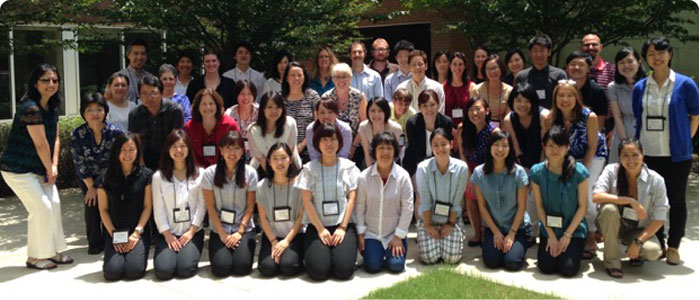
If you answered, “Yes” to any of the questions above, then continue reading to see how this program can work for you.
My name is Leslie Okada (Birkland) Roberts and I am a retired classroom Japanese language teacher who has been active in the teaching of Japanese since the early 1980’s. I have seen the changes and been involved in every aspect of Japanese language education over the years. In 2013, I joined The Laurasian Institution as the program consultant for J-LEAP. Some of my responsibilities are to serve as a ‘coach’ or mentor to the Japanese teachers in this program, plan the training, and generally share the knowledge and skills I have accumulated over the years to improve the quality of Japanese programs in the US.
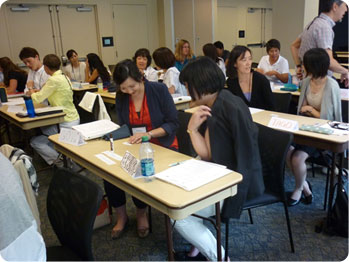 J-LEAP uses abbreviations such as LTs and ATs in explaining the program. K-12 Japanese language teachers who teach Japanese in the public, private, immersion schools are referred to as Lead Teachers (LTs) and are encouraged to apply. Assistant teachers from Japan who team-teach with the LTs are called Assistant Teachers (ATs).
J-LEAP uses abbreviations such as LTs and ATs in explaining the program. K-12 Japanese language teachers who teach Japanese in the public, private, immersion schools are referred to as Lead Teachers (LTs) and are encouraged to apply. Assistant teachers from Japan who team-teach with the LTs are called Assistant Teachers (ATs).
Each year, from the end of September to the end of December, The Laurasian Institution accepts applications from Japanese teachers in the US who are interested in having an AT as a teaching partner. In the meantime, in Japan, the Japan Foundation is accepting applications from people interested in becoming an AT in the US. Once the LTs and the ATs have been selected, we go through an extensive matching process, to make the best match possible.
In May, an online training session is held with the newly selected LTs to go over with them, the content of the training I will conduct in Tokyo with the newly selected ATs. We discuss national standards; creating standards-based lesson plans using the 5-Step Lesson Plan format; talk about the role of the AT; and discuss the 90% use of the target language as well as the differences between the Japanese and US school systems. The purpose of this training is to assure both the LT and the AT have a common understanding of the terminology and concepts when they meet at the Arrival Training.
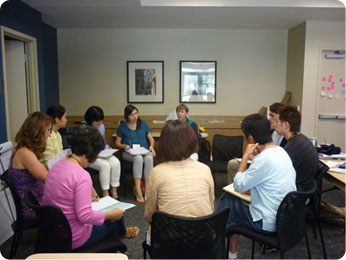 Around the last week of July, we conduct the Arrival Training in the US. This year’s training was held at Georgia State University in Atlanta, GA. (See photo of all of this year’s participants) The LTs and ATs from the year before and the newest LTs and ATs are flown to the training site and housed in dorm rooms. There are many opportunities for the LTs to get acquainted, network and collaborate during meals and in the dorms after hours.
Around the last week of July, we conduct the Arrival Training in the US. This year’s training was held at Georgia State University in Atlanta, GA. (See photo of all of this year’s participants) The LTs and ATs from the year before and the newest LTs and ATs are flown to the training site and housed in dorm rooms. There are many opportunities for the LTs to get acquainted, network and collaborate during meals and in the dorms after hours.
The training that is conducted is a dual track system so that the content for the second year LTs is not repeated and different from the first year. Upon arrival, the new LTs and ATs spend time with Vickie Virvos, a communications specialist, learning strategies for how best to communicate with one another depending upon ones personality types. All the training is practical and hands on. For example, the LTs and ATs role play various situations that might occur and resolve it, using strategies they learned earlier.
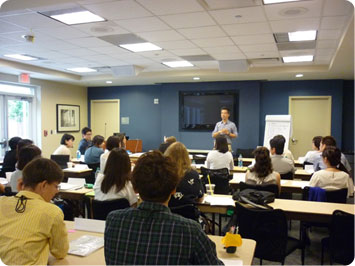 Yo Azama, a former ACTFL “Teacher of the Year,” and a favorite among the participants, conducts a session on national standards, goes over how to create standards-based lesson plans, demonstrates ‘best practices’ and guides first year LTs and ATs as they prepare a 10 minute demonstration using one of the team-teaching styles.
Yo Azama, a former ACTFL “Teacher of the Year,” and a favorite among the participants, conducts a session on national standards, goes over how to create standards-based lesson plans, demonstrates ‘best practices’ and guides first year LTs and ATs as they prepare a 10 minute demonstration using one of the team-teaching styles.
After the second year LTs and ATs work with Vickie Virvos on their goals for the second year, Yo Azama works with these pairs on assessment and standards-based thematic units. The task for these LTs and ATs is to create a summative or formative assessment and demonstrate it or explain it in a 10 minute video. All files are uploaded to Google docs to give everyone at the training access to these files.
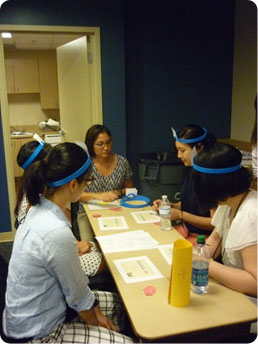 While each group of LTs and ATs are working on their curriculum, we hold individual and paired meetings with each team. During the individual meetings, the LTs and ATs can ask questions or share personal concerns with us. The purpose of these meetings is to check-in with the LT and AT to make sure all is going well at school as well as with the ATs living conditions.
While each group of LTs and ATs are working on their curriculum, we hold individual and paired meetings with each team. During the individual meetings, the LTs and ATs can ask questions or share personal concerns with us. The purpose of these meetings is to check-in with the LT and AT to make sure all is going well at school as well as with the ATs living conditions.
On the last day of the Arrival Training, the new LTs receive advice from the second year ATs, while the second year LTs offer advice to the new ATs. Later, both groups of LTs and ATs get together separately and hold a Q and A session.
Many interesting and innovative advocacy ideas are exchanged and uploaded to google docs for all participants to access. Also, this year, J-LEAP Professional Learning Communities (PLC) were established for all the teachers to be able to discuss ideas, share thoughts, ask questions, collaborate, and learn from one another.
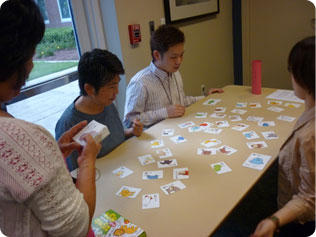 Following the Arrival Training, a colleague from the Japan Foundation and I travel to each new site to visit the new pairs to see if everything is going well. Should there be any questions regarding teaching or the classroom, I can offer suggestions or ideas for ways to deal with the concerns. Another purpose for these site visits is to determine overall, what additional training is required and incorporate it during our Follow Up Training in the fall.
Following the Arrival Training, a colleague from the Japan Foundation and I travel to each new site to visit the new pairs to see if everything is going well. Should there be any questions regarding teaching or the classroom, I can offer suggestions or ideas for ways to deal with the concerns. Another purpose for these site visits is to determine overall, what additional training is required and incorporate it during our Follow Up Training in the fall.
In November, we conduct another online session with the new LTs, prior to ACTFL. This is the Follow-Up Training and is held the week before ACTFL, in whatever city the ACTFL Conference will be held that year. Unfortunately, only the first year ATs attend this on-site training. The purpose for this online Follow-Up Training session for the LTs is to assure both the LTs and ATs share the same understanding of what is covered with the ATs during this training.
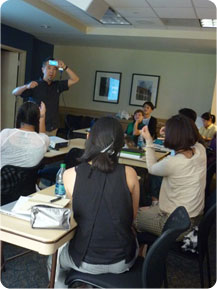 The following summer, the LTs and ATs entering into their second year with J-LEAP will fly to the Arrival Training for their last year of training. They will receive additional training and set new goals for their last year with their AT with Communication Specialist, Vickie Virvos. Once again, the returning LTs and ATs will work with Yo Azama on standards-based thematic units and formative and summative assessments.
The following summer, the LTs and ATs entering into their second year with J-LEAP will fly to the Arrival Training for their last year of training. They will receive additional training and set new goals for their last year with their AT with Communication Specialist, Vickie Virvos. Once again, the returning LTs and ATs will work with Yo Azama on standards-based thematic units and formative and summative assessments.
Additionally, we are considering granting Clock Hours for those teachers who complete all the requirements and assignments during the year. There are 4 assignments given throughout the 2 years. The assignments are as follows:
1. The first year, each new team will submit a 20 minute team-teaching video in the fall of year one to establish a baseline.
2. In early December of year two, the team will submit a second, 20 minute video segment of a lesson where the AT is teaching the class. It would be desirable to video the AT interacting with the students demonstrating best practices. The purpose of this video is to showcase the AT teaching the class. This video should also be included in the ATs E-Portfolio.
3. During the second year, the LT/AT is required to submit an assessment sample. The assessment piece will include a sample of team-developed assessments that accompany a unit and puts into practice what was learned at the Arrival Training. This will be uploaded to the homework folder on google drive.
4. The third video is due in early May of year 2 showing the LT and AT team- teaching. They will answer the same questions and reflect on their team-teaching and write about how their teaching has improved/changed as a result of participating in this program.
One of our goals is to “raise the bar” of Japanese language teaching in the US, but it takes teachers who are willing to put in the time and the effort to make it happen. Teachers who have been through this program have improved their teaching, increased the percentage of Japanese they speak in the classroom; gained a networking group of Japanese teachers who have gone through the same training; gained confidence as well as leadership skills. We are very proud of the teachers and their assistants who have made a definite impact in Japanese classes throughout the USA.
J-LEAP applications for the 2015-2017 school year are available on the Japan Foundation Los Angeles website and on The Laurasian Institution website.
https://www.jflalc.org/jle-j-leap.html
http://www.laurasian.org/Programs.htm
Come and join us as we work to “raise the bar” and change our programs into more effective, dynamic, thriving Japanese programs in this country. Remember, it all starts with you, the teacher! I look forward to working with you.
 Author Bio: Leslie Okada Roberts
Author Bio: Leslie Okada RobertsLeslie Okada Roberts’s involvement in Japanese language education nationally and internationally has spanned the past 30 years. Since retiring from the classroom in 2013, she works part time as a language program consultant for The Laurasian Institution which manages the J-LEAP program.
She was the founding president of both WATJ (Washington Association of Teachers of Japanese) and later NCSTJ/NCJLT (National Council of Secondary Teachers of Japanese/National Council of Japanese Language Teachers), now known as AATJ.
Her Japanese class was filmed by WGBH, Boston as part of a 26 video library series on Teaching Foreign Languages. These videos are still used for Staff Development/Teacher Training purposes.
Because Leslie is passionate about Japanese language teaching, her goal is to support as many teachers by sharing methods, strategies, mistakes, philosophies, ideas, etc. which she has learned from and experienced, to help teachers produce strong Japanese programs at their schools.